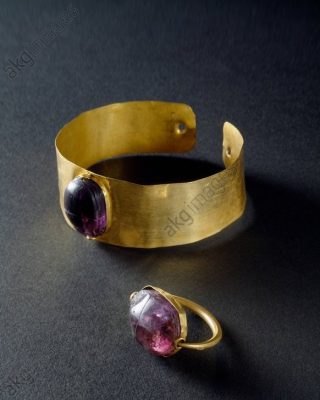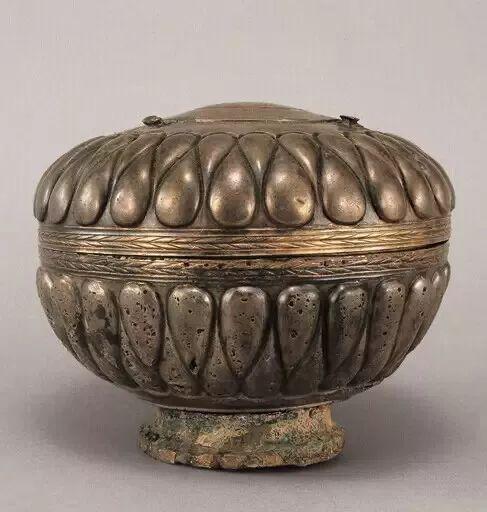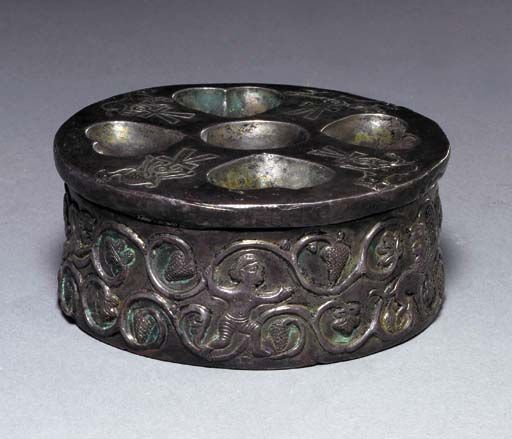
Source https://www.rmo.nl
Dagger and sheath
On the handle of this dagger is the image of a god. It resembles many bronze statuettes found in Byblos with gold gilding. It is the god of the Obelisk Temple. The scabbard shows animals being taken to a man on a donkey: an ibex, a lion, a baboon, a dog and a fish. The man is probably a king. The association with donkeys is common among the male elite of this period, although it is not clear why.
Material: gold, silver and ivory
Period: 2000-1600 BCE

Source https://www.rmo.nl
balm vase
A casket with the name of Pharaoh Amenemhat IV on the lid has been found in Tomb 2. This tomb belongs to the king of Byblos named Ipy-Shemu-Abi. An embalming vase bearing the name of Pharaoh Amenemhat III, with a hieroglyphic text on the lid that the vase contained perfume or incense, has been found in Tomb 1. Since Amenemhat III and IV are father and son, it seems logical that the royal tombs 1 and 2 also belong to a father and a son. Since we know that Tomb 2 belonged to ‘the son Ipy-Shemu-Abi’, Tomb 1 probably belongs to his father Abi-Shemu. Unfortunately, however, nothing has been found in Tomb 1 to actually support this hypothesis.
Dimensions: height 12.1 cm
Material: obsidian and gold
Period: 1818-1773 BCE (12th dynasty)
Site: Tomb 1, of Abi-Shemu, king of Byblos

This box bears the name of the Egyptian pharaoh Amenemhat IV on the lid.
Dimensions: 9.8 (height) x 15.2 (width) cm
Material: obsidian and gold
Period: 1772-1764 BCE (12th dynasty)
Site: tomb 2, of Ipu-Shemu-Abi, king of Byblos
Source https://www.rmo.nl

Source https://www.rmo.nl
Mirror
Egyptian artifacts have been found in the royal tombs of Byblos with names of pharaohs from about 1800 BC. stand. The tombs themselves may be two centuries younger: other grave goods, including the pottery, are believed by some archaeologists to be around 1600 BC. dated. That would mean that the gifts with the pharaoh names were not given to the kings of Byblos until two centuries later. And that is quite possible. It was not uncommon in Egypt at the time to remove objects from older tombs of pharaohs, princes and courtiers and then give them away as gifts.
Dimensions: length 47 cm
Material: silver and gold
Period: 2000-1600 BC.
Found: tomb 2, of Ipu-Shemu-Abi, king of Byblos

Source https://www.rmo.nl
The Egyptian scarab on this bracelet has been detached from the ring it was once attached to and reused.
Dimensions: diameter 6 centimeters, w. 2.2 cm
Material: gold and amethyst
Period: 2000-1600 BC.
Found: tomb 2, of Ipu-Shemu-Abi, king of Byblos
Inv. nos. 16240 [bracelet], 16249 [ring]
Beirut, National Archeological Museum


https://dukesglobaladventures.com/2018/06/30/national-museum-of-beirut-jewelry/

Source https://www.rmo.nl
Necklace with pendant
This pendant made in Byblos is inlaid with carnelian, turquoise, faience and lapis lazuli. King Ipy-Shemu-Abi is depicted on the pendant as a pharaoh.
Dimensions: 4.5 (height) x 5 (width) cm
Material: gold and marquetry
Period: 2000-1600 BC.
Found: tomb 2, of Ipu-Shemu-Abi, king of Byblos

This ring contains a small cylinder seal of lapis lazuli and is decorated with sphinxes, hares and wickerwork. Such decoration is typical of the cylinder seals produced in Byblos during this period.
gold and lapis lazuli
Period: 2000-1600 BC.
Found: the royal tombs of Byblos
Source https://www.rmo.nl

In the temple floors of Byblos many objects are buried in pits and jars, including axes of silver and gold. Some of those items were created in Byblos itself. Molds for jewelry, figurines and weapons have been found around the Obelisk Temple. This suggests that the shrine may have had its own metal workshop.
Dimensions: height 20 centimeters
Material: gold
Period: 2000-1800 BC.
Location: Byblos
Source https://www.rmo.nl

https://mainzerbeobachter.com/2022/10/07/de-mozaieken-van-byblos/
- TELL EL-DABCA AND BYBLOS: NEW CHRONOLOGICAL EVIDENCE; Karin Kopetzky
Ägypten und Levante / Egypt and the Levant, Vol. 28 (2018), pp. 309-358 https://www.jstor.org/stable/26664995 - Relations between Byblos, Egypt and Mesopotamia at the end of the third millenium B.C. A Study of a Montet Jar. [article]
O. Tufnell, W. A. Ward. Syria. Archéologie, Art et histoire Année 1966 43-3-4 pp. 165-241 https://www.persee.fr/doc/syria_0039-7946_1966_num_43_3_5872












